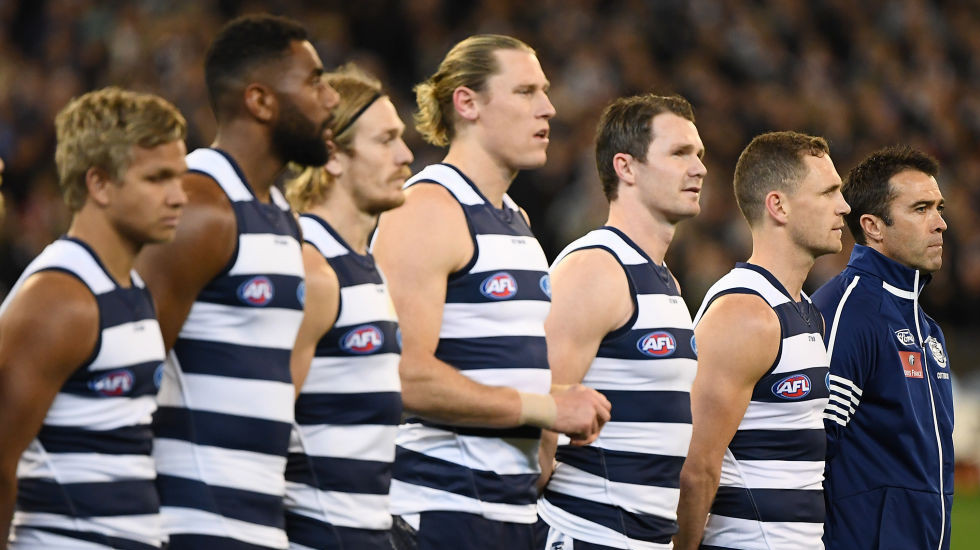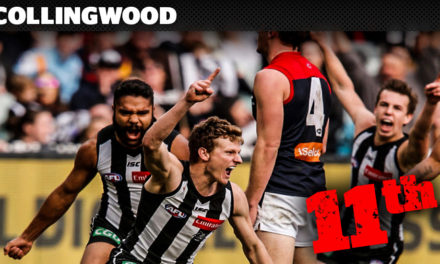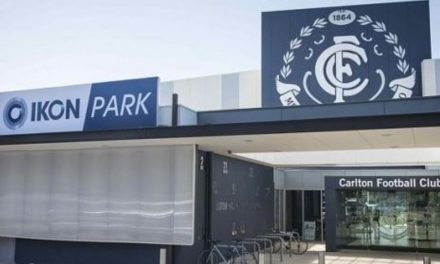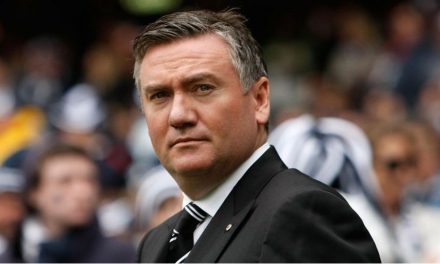The Cats line up for the national anthem before last week’s qualifying final loss against Collingwood. Photo: GETTY IMAGES
Older generations of Geelong fans could have been forgiven for having the odd nightmarish flashback this week.
As the Cats prepare to play for their finals lives on Friday night at the MCG, it’s an old September adversary waiting to greet them, poised to scuttle their best-laid plans once again.
Until Geelong finally broke what had become a 44-year premiership drought in 2007, the mere mention of the name West Coast was enough to have an entire club breaking into a cold sweat.
Three times in four years, it was the Eagles who played September spoiler to the Cats’ free-flowing, high-scoring and highly-entertaining teams under the coaching of Malcolm Blight.
West Coast ran right over the top of Geelong in the 1992 grand final after the Cats had led by as much as four goals late in the second quarter. They’d already pipped them at the post in a preliminary final the year before. And the Eagles reprised their grand final win only two years on rom their first flag in 1994 with a comprehensive 80-point belting of their by-now scarred opponent.
All of which has no bearing on this finals series 25 years on, of course. But given not only that history, but the circumstances surrounding this semi-final clash, perhaps there’s just a few more demons inside heads down Kardinia Park way as a result.
Is this final more important to Geelong than any other it has played since its last premiership in 2011? Well, yes, that might actually be the case.
Why? Because that finals record since the 2011 flag now reads an even more unflattering 3-10. Because another early exit would make it seven finals campaigns since the premiership without even reaching another grand final.
And because a 3-11 record in September, a strike rate of just 21.4 per cent, would really deserve the sort of infamy attached to Collingwood’s nightmarish spell between 1958-90 when the Magpies played in nine grand finals (including a draw) without winning a single one.
That made the “Colliwobbles” famous. But even then the Pies could claim that they were at least getting there, still winning 17 and drawing one of 48 finals played during that shocking grand final losing streak, a winning percentage of 36.5.
Should the Cats lose to the Eagles, since the 2011 triumph they will have lost three preliminary finals, gone out in week one of September twice and the second week twice, both occasions going out in straight sets after finishing top four.
Also making this far from your regulation finals failure, though, is the contrast between home and away and September form. In the eight seasons since the last premiership, Geelong has won 122 and drawn two of 175 regular season games, a winning percentage of more than 70, a far cry from that three wins from 10 finals over the same journey.
And so is coach Chris Scott’s record phenomenal by any historical standards, let alone today’s super-competitive 18-team competition.
In fact, Scott’s winning percentage of 69.5 per cent after 213 games and 10 seasons is easily the best of any of the 41 men who have coached at least 200 VFL/AFL games.
The only others who even come close are John Longmire, who is going at 64.2 per cent after 218 games in charge of Sydney, and Hawthorn coaching master Alastair Clarkson, who sits at 61.8 per cent after 351 games.
And yet, even there, the naysayers do have some ammunition. Clarkson, of course, has four premierships to his name as coach. Longmire, like Scott, has just the one, but has taken his teams to three grand finals.
Clearly, the gap between Geelong’s home and away achievements and those in finals has grown with each passing year. Just why is the question to which anyone involved with the operations at Kardinia Park would love a definitive answer.
One theory is that the Cats’ home and away record continues to be inflated by its sizeable home ground advantage, the only one-team occupant of a venue in the AFL’s foundation state, on which it has won an amazing 55 of 63 games since winning the 2011 flag. Geelong’s record at the MCG over the same period is 26 wins and 24 losses. On the road, it’s exactly 50 per cent, 22 wins, 22 losses and one draw.
But they were 4-1 at the MCG this season until last Friday night’s qualifying final loss to Collingwood. And they were at least 3-3 on the road, too, with two of those defeats by just 11 points and one point.
Geelong was 11-1 after 12 rounds this season. Since then it is 5-6, with alternating wins and losses. Yet even after that second half-season downturn, it still finished the regular season with statistically the stingiest defence in the AFL and second-most prolific attack, a balance no other finalist has got near.
The Cats were also ranked No.1for contested ball differentials, traditionally a very reliable finals measuring stick, and was the second most efficient side in the competition in terms of percentage of goals from inside 50 entries.
They’re premiership quality numbers. Certainly not those befitting a side in danger of becoming the first side to finish on top of the ladder and go out in straight sets since North Melbourne all the way back in 1983.
The upside? The Cats were outplayed when it counted against Collingwood yet still finished only 10 points in arrears, still a theoretical winning chance with three minutes to play. They had more forward entries, broke even in the clearances and won the contested ball handsomely.
Perhaps the most telling stat, however, besides the scoreboard, was tackles inside 50, in which they trailed the Pies 8-16.
It was forward pressure delivered via the likes of Gary Ablett, Luke Dahlhaus, Gary Rohan, Tom Atkins and Gryan Miers which characterised the dynamic football Geelong was playing in the first half of this season.
Of that group, only Atkins could claim to have delivered anywhere near his capacity. So there is certainly plenty of scope for improvement.
The downside? Well, there’s several. The most significant might be that it’s rarely a qualifying final loser has to take on an elimination final winner which also happens to be reigning premier with a very good recent record at the venue at which the game will be played.
Qualifying final losers had a tremendous record of bouncing back in their semi-finals between 2008-13, all 12 of them eventually earning a preliminary final spot. But the tables have turned significantly since then, with half of them bowing out in straight sets.
It’s happened to Hawthorn twice in the past three completed seasons, and the Hawks on either occasion weren’t up against as seasoned an opponent as Geelong will be on Friday evening. Of course, neither did the Hawks suffer much of backlash given those three straight premierships from 2013-15.
Geelong, in contrast, has been eight years in the flag wilderness now, nothing like the several decades it waited previously, but for a side consistently in contention, galling nonetheless.
This is a game the Cats simply must win. Not just to stay in the flag race, nor even to settle some scores against an old foe from the early ‘90s. But simply to be able to rebut the claim that for all the routine victories over a long period now, Geelong remains just a pretender.
*This article first appeared at INKL.











I would argue, Rohan, that any team that finishes top four has their H&A results inflated by home ground advantage. Case in point – Richmond 2017 – 2019.
And Sydney proves the point. Their ground was a fortress between 2012 and 2016, and they finished 3rd, 4th, 1st, 4th and 1st. They performed better than Geelong has in finals though, making three grand finals, because they got to play many of their finals at their fortress. Unsurprisingly though, they lost two out of three grand finals at the MCG, both times after finishing top of the ladder. Ironically, their flag win was when they were the underdogs.
If Geelong had been granted the same advantage as Sydney – i.e. home finals – their finals record these last 7 years would read much better.
Over those seven years, they’ve played 7 finals at their opponent’s home ground and one just once (Hawks qualifying final 2016).
If you look at their finals MCG record from 2012 onwards, it’s not real flash.
They’ve lost 5 out 6 finals against MCG tenants. Of three of those six matches, they were eligible for a home final, and lost 2 of the 3. The third they should have lost but for Isaac Smith’s errant kick after the siren.
Against non-MCG tenants, their record is 2 and 2. However, in all four cases they were eligible for a hime final
All up, seven times they’ve played at the MCG when eligible for a home final, and they’ve lost four of them. If they played those seven at Kardinia Park that would look quite different.
And in total, they’e played 10 games at the MCG and lost seven.
Everything says that home ground advantage is significant in finals.
It’s easy to see why they want to play finals at their home ground. Just like Richmond, Sydney, Hawthorn, West Coast, Brisbane, GWS and Collingwood etc do.
Losing would be a total disaster, but how would winning tonight change much unless they at minimum won the prelim as well?